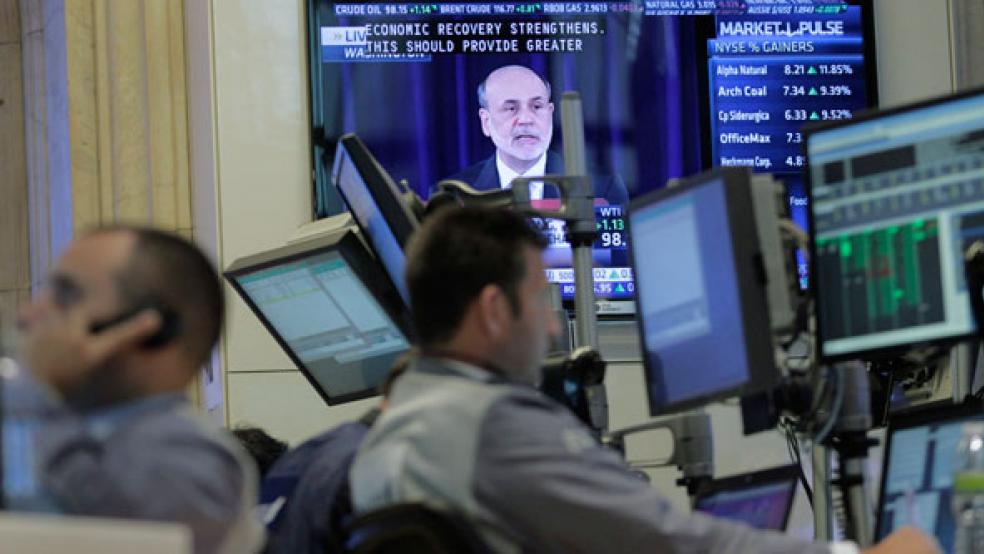If you have even a mild interest in investing, it’s hard to avoid taper talk, the seemingly endless speculation as to when the Federal Reserve will begin winding down its $85-billion-a-month bond-buying stimulus, also known as QE3.
The Central Bank has hinted about that “tapering” for months, injecting volatility and uncertainty into markets as investors try to hedge against the prospect of higher interest rates and a potential drop in stocks after the removal of the program that’s been propping them up. Gradual improvement in the overall economy has 65 percent of economists surveyed by Blooomberg expecting that that the Fed will announce the beginning of the end of QE3 at its next scheduled meeting, September 18, especially if the September 6 jobs report shows continued improvement.
Back in June, when Ben Bernanke signaled that the Federal Open Market Committee might start pulling back on the stimulus, stocks took a dive and interest rates spiked even though the Fed chief said the slowdown in bond buying would be gradual and contingent on an improvement in the U.S. unemployment rate. Just weeks later, rates leveled out and stocks hit new record highs. Now that it appears the Fed may soon act, should individual investors hightail it out of the markets? Advisor and financial planners say the answer is emphatically: No.
DON'T PANIC
“Everyone know this is coming, so it’s not going to be a cataclysmic event,” says Eleanor Blayney, a consumer advocate for the professional Certified Financial Planner Board. “There may be a large market move on the day it’s announced, but it’s unexpected news that really drives the markets profoundly and permanently. People should take all of this with a large grain of salt.”
RELATED: COULD THE FED ACTUALLY BE HURTING STOCKS?
It’s never a good idea to make major buying and selling decisions based on emotion, and this case is not different. Instead of panicking, individual investors should take a look at their current asset allocation and make sure they’re satisfied with the level of risk they’re taking, says Richard Coppa, director of Wealth Health. “Once you understand your risk profile and know you can take the volatility, stay the course,” he says.
STOCKS AREN'T DOOMED
If the Fed starts to pull back on quantitative easing, it will do so because it believes the economy is finally strong enough to stand on its own, and that’s a good thing for stocks. A gradually improving unemployment rate, growing consumer spending and strong corporate earnings have all contributed to the recent run up in stock prices, notwithstanding this week’s slide. The economy expanded more than expected in the second quarter, with GDP growing at a 1.7 percent annual rate. Economists largely expect that growth to accelerate through the end of the year.
“Certainly, we’d rather see investment opportunities created by economic growth as opposed to artificial suppression of rates,” Blayney says. “Everybody would agree that economic growth is more encouraging to investments than the fact that financing investments in cheap.”
An analysis by Leuthold Group found that rising interest rates do not preclude a continued stock rally. In the past 60 years, stocks prices and long-term rates have risen in tandem a dozen times, and stocks and interest rates have been in a “joint rising mode for a full one-third of the time since 1955,” the report finds.
When the Fed starts to taper, there certainly may be short-term volatility in the market, but there are also plenty of reasons to believe that the bull market will keep on charging.
RELATED: WHY BERNANKE CAN STOP BEING OUR DESIGNATED DRIVER
A ROUGH ROAD FOR BONDS
The outlook for bonds is less rosy. Treasury yields spiked early this week amid continued speculation about tapering. Yields on benchmark 10-year notes were at 2.7 percent Wednesday, just shy of their 2-year-high reached in early July. (Bond prices and yields move in opposite directions.)
“We still haven’t seen the full extent of the adjustment in the bond market,” says David Joy, chief market strategist with Ameriprise Financial. “Bond prices are going to weaken further. Consumers still need to be a little more defensive with their fixed-income investments.”That doesn’t mean selling off all of your bond holdings. If you own individual bonds and pan to hold them until maturity, then you don’t need to make any changes at all. If you own bonds funds, find out the average duration of their underlying bonds. The shorter the duration of your bond funds, the less sensitivity they have to interest rate movement. Switching from intermediate- to short-term funds will shield you from interest rate hikes but will also bring a lower yield.
MORE BANG FROM YOUR BANK
It’s also worth remembering that rising rates are not entirely a bad thing, and several years of historically low rates have been really rough on retirees. While we may be nearing the end of an era for bond investors who have enjoyed an historic bull market that’s lasted more than 30 years, rising interest rates do have perks—just ask anyone who keeps money in a savings account or is considering buying an annuity to help fund retirement. Given that savings rates are so bad, keep your cash in a money-market account or a very short-term CD, so that you can access it when rising rates do start to show up in savings vehicles.
“There has effectively been a transfer of wealth in recent years from savers to those who were willing to take more risk with their investments,” says Paul Jacobs, a financial planner with Palisades Hudson Financial. “That can’t last forever, and, ultimately, it will be beneficial in the long-term for rates to return to more normal levels.”




